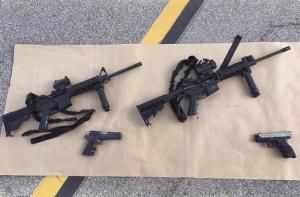Gun safetyReducing civilian firepower would boost police, community safety: Expert
A recent study examined data on the number of homicidal deaths of police in two groups of states with roughly equal number of police officers – the eight states with the lowest levels of gun ownership and the twenty-three states with the highest rate of gun ownership. The study found that, over the period from 1996 to 2010, the rate of police homicide in the high-gun prevalence states was three times as high as the rate of police homicide in the low-gun prevalence states. In addition to restricting the firepower a person can amass, a Stanford University expert advocates efforts to build trust between communities and law enforcement agencies as a way to enhance both police and citizen safety.

Weapons used in the San Bernardino massacre // Source: theconversation.com
Improved community bonds and gun control that limits the amount of firepower that people can access would increase both police and citizen safety, a Stanford scholar said.
Stanford News Service recently interviewedJohn J. Donohue III, a law professor who has been conducting empirical research on gun violence and gun control for more than twenty-five years. Donohue is the C. Wendell and Edith M. Carlsmith Professor of Law at Stanford.
When and how can the police legally shoot and kill a person? Are there federal and state differences?
Police use of deadly force is typically constrained by both applicable state law and by the United States Constitution. While there are some state law differences, they tend to be less important than the attitudinal differences that exist in various regions of the country that may lead prosecutors and juries to reach different conclusions based on their differing worldviews. In general, the more dangerous the crime that the officer believes someone to have committed and the greater the threat to safety the individual poses, the greater the ability of the police officer to use force, including deadly force.
As the Supreme Court stated in Graham v. Connor [1989], “All claims that law enforcement officers have used excessive force – deadly or not – in the course of an arrest, investigatory stop, or other ‘seizure’ of a free citizen should be analyzed under the Fourth Amendment and its ‘reasonableness’ standard.” The Supreme Court went on to stress that “the ‘reasonableness’ of a particular use of force must be judged from the perspective of a reasonable officer on the scene, rather than with the 20/20 vision of hindsight.”
